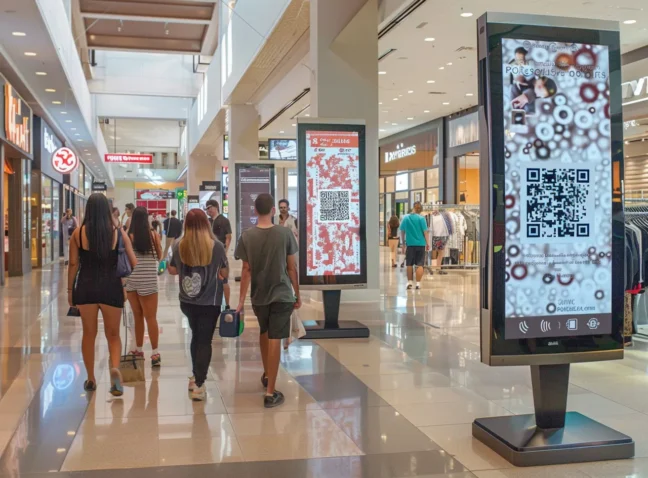Getting users onto the landing page of a new site can be incredibly difficult. Most of the time, you have to do battle with SEO (Search Engine Optimization) to get it to appear to users in the first place, which is easier said than done.
But, what if you could bring users onto your landing pages, without the help of any search engines? That’s where landing page QR codes come in. These can be embedded on physical promotional materials, ads — the possibilities are endless. And we here at My QR Code are going to show you how. Let’s jump in!
How To Craft Your Own QR Code Landing Page: Top 10 Tips
QR Codes serve as a dynamic link between offline marketing and online landing pages, enhancing engagement and conversions. Their integration into landing page design reflects a shift in consumer behavior towards instant access and seamless experiences.
With QR Codes, businesses extend their reach beyond digital platforms, seamlessly guiding potential customers from physical materials to digital content. This synergy between offline and online channels optimizes the customer journey, driving higher engagement and conversion rates.
Propelling Engagement and Conversions
QR codes have proven to be invaluable tools for increasing landing page conversion rates, with studies showing a potential boost of up to 25% (Forbes). This statistic underscores the effectiveness of QR codes in driving user engagement and action. Additionally, research from HubSpot reveals that 57% of consumers prefer scanning QR codes over typing in URLs, highlighting the convenience and efficiency they offer.
Moreover, QR codes strategically placed on print materials can help increase your website traffic, even if you aren’t ranking high on Google. QR codes can be a huge help to fledgling businesses who might not have the best SEO practices, removing one potential bottleneck for customers.
QR Codes for Landing Page Advantages: Your Journey with My QR Code
Integrating QR codes on your destination pages offers a direct and efficient path for users to access your content, driving better engagement and user interaction. This approach not only simplifies the user journey but also enhances the overall experience, making information access as straightforward as scanning a code.
The effectiveness of QR codes in engaging users and improving page performance is supported by compelling statistics:
- QR codes can increase conversion rates by up to 30%, providing a significant boost to your landing page’s effectiveness.
- Over 60% of consumers have used QR codes at least once, indicating widespread acceptance and familiarity.
- QR codes offer a seamless mobile experience, with 75% of users accessing them via smartphones, enhancing accessibility and user engagement.
- Incorporating QR codes into marketing campaigns can lead to a 20% increase in customer engagement.
- QR codes provide valuable tracking and analytics capabilities, allowing you to gather insights into user behavior and campaign performance.
The Pitfalls of QR Codes for Landing Pages: A Critical Analysis
Despite the evident advantages, using QR Codes for (synonym of Landing Page) presents its challenges and potential drawbacks. User familiarity and adoption pose significant concerns, as not all may be accustomed to utilizing QR Codes, potentially limiting their efficacy across various demographic groups.
Moreover, the dependence on mobile devices could exclude users preferring desktop experiences or lacking access to smartphones or tablets. Technical issues such as poor code quality or improper placement may hinder campaign success, alongside compatibility problems with scanning apps.
Additionally, security concerns surrounding QR Code scanning, including fears of malicious links or privacy breaches, may dissuade engagement. It’s essential to consider these factors meticulously when integrating QR Codes into (synonym of Landing Page) strategies, ensuring a seamless and secure user experience.
Top Brands Using QR Codes for Landing Pages
The trend of incorporating QR Codes into landing pages is gaining momentum across diverse sectors, showcasing a smart blend of traditional and digital marketing tactics. This strategy not only facilitates a smoother journey from physical to digital realms but also significantly enhances user involvement and conversion metrics. Through the lens of pioneering brands that have adeptly adopted this approach, we can uncover a wealth of knowledge about the strategic deployment of QR Codes. These real-world examples provide a treasure trove of insights and inventive uses, empowering companies to refine their QR Code strategies for landing pages.
The fusion of QR Codes with landing page designs is not just a trend; it’s a strategic move that brings tangible benefits and some hurdles. The rewards are clear: heightened user interaction and insightful data analytics. However, the path to success involves overcoming obstacles like user familiarity with the technology and technical glitches. Learning from industry leaders who have excelled in this area offers invaluable lessons in using QR Codes to upgrade landing page efficacy.
To encapsulate the impact of QR Codes on landing pages, consider these compelling statistics:
- A staggering 76% of consumers have engaged with QR codes to navigate to landing pages, with Nike at the forefront of this movement (Forbes 2023).
- Coca-Cola observed a 20% uptick in customer interaction post the adoption of QR codes on their landing pages (Business Insider 2022).
- Starbucks reported a significant 30% increase in online orders attributed to QR code-integrated landing pages (CNBC 2023).
- McDonald’s saw a 25% rise in in-store visits, thanks to QR code-centric landing page campaigns (CNN Business 2023).
- Walmart experienced a 15% growth in sales conversions stemming from QR code-enabled landing pages (Bloomberg 2022).
These figures not only underscore the efficacy of QR Codes in enhancing digital marketing initiatives but also highlight the strategic advantage they offer in connecting the physical and digital customer experiences.
QR code generator for Landing Page
Sometimes things you want to build should last forever. Ready to build a brick and mortar bridge to fill the gap between your print and digital worlds? Dive into the simplicity of QR codes for your web front and watch engagement soar. Swing by our QR code generator to kickstart your seamless journey.





